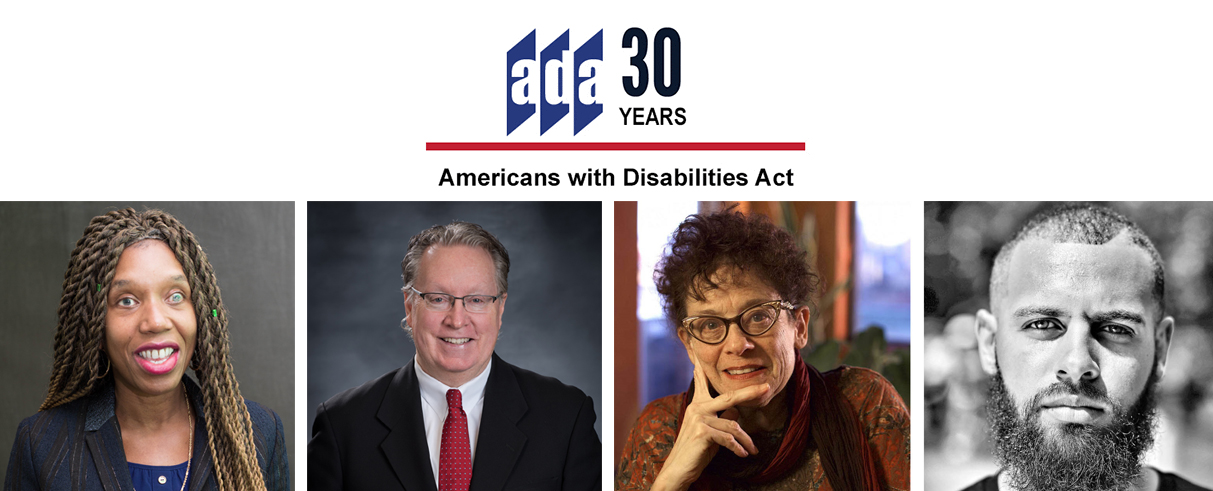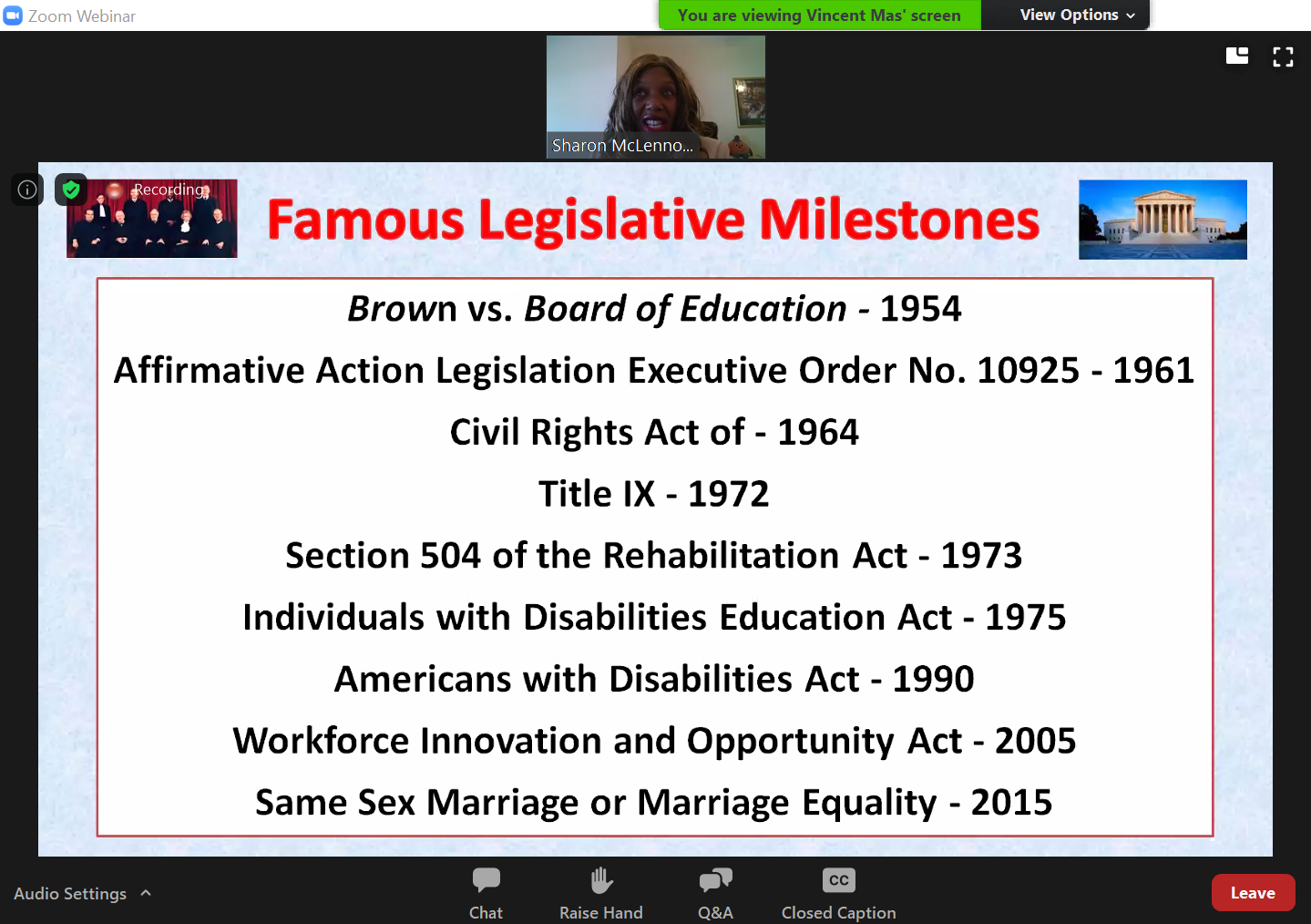Berkeley College Celebrates 30 Years of the Americans with Disabilities Act in Forum: "Race, Gender, Sexuality and Disability - the Intersection of Social Justice"

Thursday, July 23, 2020
BERKELEY COLLEGE CELEBRATES 30 YEARS OF THE AMERICANS WITH DISABILITIES ACT IN FORUM:
“RACE, GENDER, SEXUAL ORIENTATION AND DISABILITY –
THE INTERSECTION OF SOCIAL JUSTICE”
Virtual Audience Learns about the ADA’s Challenges and Triumphs

Share the News: @BerkeleyCollege #ADA30 #NewsBerkeley
In honor of the 30th anniversary of the signing of the Americans with Disabilities Act (ADA), the Office of Disability Services at Berkeley College hosted a free virtual event highlighting the landmark legislation on July 22, 2020. Sharon McLennon-Wier, PhD, CRC, LMHC, Berkeley College Director of Disability Services (far left, above), organized the event, titled “Race, Gender, Sexual Orientation and Disability: The Intersection of Social Justice.” More than 350 people registered for the event.
Guest speakers who addressed social justice concerns were Simi Linton, PhD, author and filmmaker (second from right, above) and Dustin Gibson, community builder and advocate for persons with disabilities (far right, above). Michael J. Smith, President of Berkeley College (second from left, above) welcomed the participants.
“We know that while we have come far, we still have much further to go when it comes to ensuring equity and inclusion in basic protections such as healthcare, education and employment opportunities for people with disabilities,” said President Smith. “Education is a game changer, but it is up to each of us to elevate our voices,” he said.
McLennon-Wier set the scene by introducing American ideologies that established the framework for the foundation of disparity, including individualism, capitalism, democracy, consumerism and meritocracy. She shared what it means in our society to have privilege, and that those in this dominant group were largely white and male in all aspects, including employment and access to healthcare, education, and other opportunities.

“We want to celebrate how society as a whole has benefited from this legislation in transportation, technology, electronic media, and more. However, it is important to understand the impact of social justice for people with varying levels of disability and other groups,” she said, pointing out that people with disabilities – as well as those in the LGBTQ community – usually do not have expectations of themselves and perceptions about opportunities like those in the dominant privilege group.
McLennon-Wier shared statistics to illustrate the high toll discrimination is taking on minority groups in the United States. “You see how the pandemic is affecting minority status,” she said. “Systems of oppression are deeply rooted and legislation helps, but it doesn’t provide protection.”
The statistics presented for the LGBTQ group showed it is the least protected among all groups described. It is very dangerous for this group to report so that while the statistics are shocking, McLennon-Wier pointed out that the numbers could but be greater because not all people who identify as part of this group may be reporting. They have a greater degree of fear of oppression, inequality and discrimination, and comprise the group ranking the highest in food insecurity and homelessness.
One hopeful note is a recent upholding by the U.S. Supreme Court in favor of a person who brought suit against an employer after being fired for wanting to play on the (company’s) softball team.
“It’s about being able to stay alive and healthy,” McLennon-Wier said.
Congress Recognizing ADA Legislation as a Civil Right Is a Huge Achievement
“One of the major accomplishments of the disability rights movement was convincing Congress that disability is a civil and human rights issue,” said Linton. “This shifted the perspective from benevolence to rights.”

In addition to what it does not cover, Linton provided her perspective about how the ADA is doing as a law. She was part of a group in New York City that fought to get accessible taxi transportation service. Only 25 percent of the subway system there is wheelchair accessible and she uses a power wheelchair. The accessible subway closest to her home is a mile away. She has not used the New York City subway system in 45 years. A legal suit has been brought against the Metropolitan Transit Authority, which, according to Linton, is notorious for having dysfunctional elevators.
Regarding employment data from 10 years ago, Linton said that 90% of the legal cases then were decided in favor on the side of the employers, and that it has only been in the last 10 years that her voting place became accessible. “This kind of experience is disenfranchising to the population the ADA was designed to protect,” she said. Within a different political environment, Linton admits change may be possible.
Linton suggested that the United States might legislate to provide a mechanism for integration, explaining that while inclusion gets one in the door, integration means to participate actively within the organization or entity. Desegregation is a worthy goal, she said, but does not ensure equity.
Dustin Gibson devotes his work to a practice of disability justice that can live, build, support and be implemented by marginalized communities to address the intersection of race, class and disability. He acknowledged the work of predecessors that not only brought forth the ADA legislation, but also shed light on citizenship and our rights to move and to liberate, as a piece of legislation attempting to provide that right to disabled people. He also recognized that, along with other civil rights legislation, this effort came from a black organizing tradition, citing how college students organized a framework that was given to them in Mississippi by their ancestors in the early 1960s.
“In the context of the nation-state, schools are still segregated at the same rate and there is segregation within segregation,” said Gibson. “Nothing is being done to diminish the violence toward transgender men and transgender women. There are limits to legislation. We have to introduce practices of disability justice that go beyond the ADA.”
Gibson also asked the audience to consider how we view disability in society and noted that ADA excludes access to some. He gave examples of those in prisons and people with addictions. The ADA includes those with a history of addition and are in recovery, yet a majority of people with addictions are poor, brown and black, who were unable to get prior care because they did not have access to that care and those services.
He explained that outside of Pittsburgh, created by Andrew Carnegie, is a steel mill town with a lot of toxicity in the land and the air. It has among the lowest air quality in the United States, Gibson said. “These are the places where predominantly black and brown people live. It is located near a penitentiary with the same type of health conditions. It’s the reason why ghettos have a prevalence of people with asthma and other conditions so when it comes to a pandemic, you are more at risk, and have a disproportionate amount of people dying.”
Gibson said that people are in congregational settings because they do not have home support. “The ADA still places the burden on disabled people to do something,” he said.
He also noted that this is a global reality and some countries, like Japan and Costa Rica, are better at addressing these situations.
Going forward, Gibson believes we need to abolish systems in congregate settings, such as jails and prisons, and group homes, places that are traditionally used to warehouse, where people can’t go outside because they are under constant surveillance.
Looking at the Bright Side
While all speakers acknowledged that in today’s reality, using our wisdom is certainly welcome when at times things are chaotic, there also is reason to be hopeful going forward.
Linton said, “The public is increasingly understanding of disability as a civil right.” She sees the disabled as a growing group that is more organized and working together. She noted there is a growing expressive arts movement that brings forth the value and wisdom of the disabled, and she cherishes the friendships and collaboration of her community.
About Berkeley College
Berkeley College, founded in 1931, is a career-focused institution accredited by the Middle States Commission on Higher Education that offers students Master’s, Bachelor’s, and Associate’s degree and Certificate programs in more than 20 career fields. The College has campuses in Midtown Manhattan and White Plains, NY, as well as in Newark, Paramus, Woodbridge and Woodland Park, NJ, with more than 5,700 students enrolled. In addition, Berkeley College Online® serves a global population. U.S. News and World Report has named Berkeley College among the Best Colleges for Online Bachelor’s Programs and among the Best Online Bachelor’s Programs for Veterans, for seven consecutive years. The website address is www.BerkeleyCollege.edu
The mission of Berkeley College is to empower students to achieve lifelong success in dynamic careers.
- end -
Sharon McLennon-Wier: https://berkeleycollege.edu/newsroom/images/ALL_SMcLennonWier_072320.jpg
Simi Linton: https://berkeleycollege.edu/newsroom/images/ALL_ADALinton_0722201.jpg
Dustin Gibson: https://berkeleycollege.edu/newsroom/images/ALL_ADAGibson_0722201.jpg
Michael J. Smith: https://berkeleycollege.edu/newsroom/images/ALL_MSmith_072320.jpg

